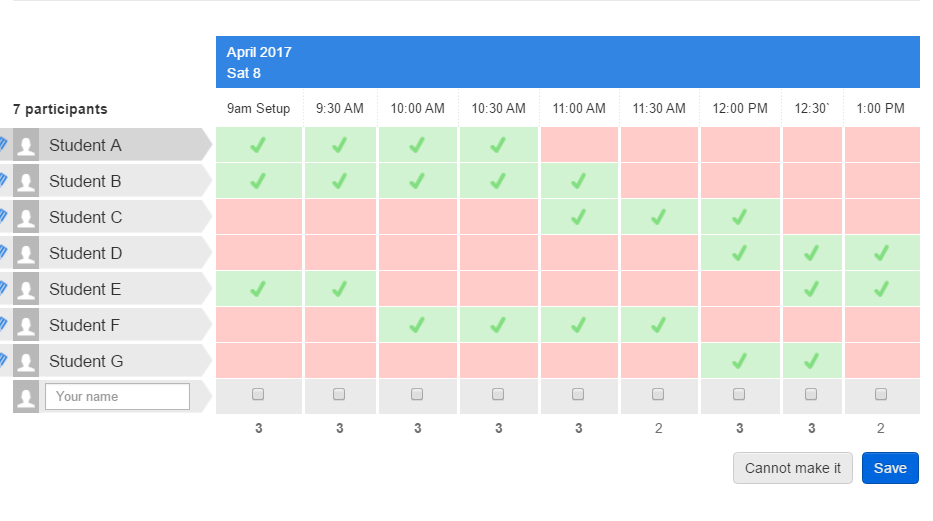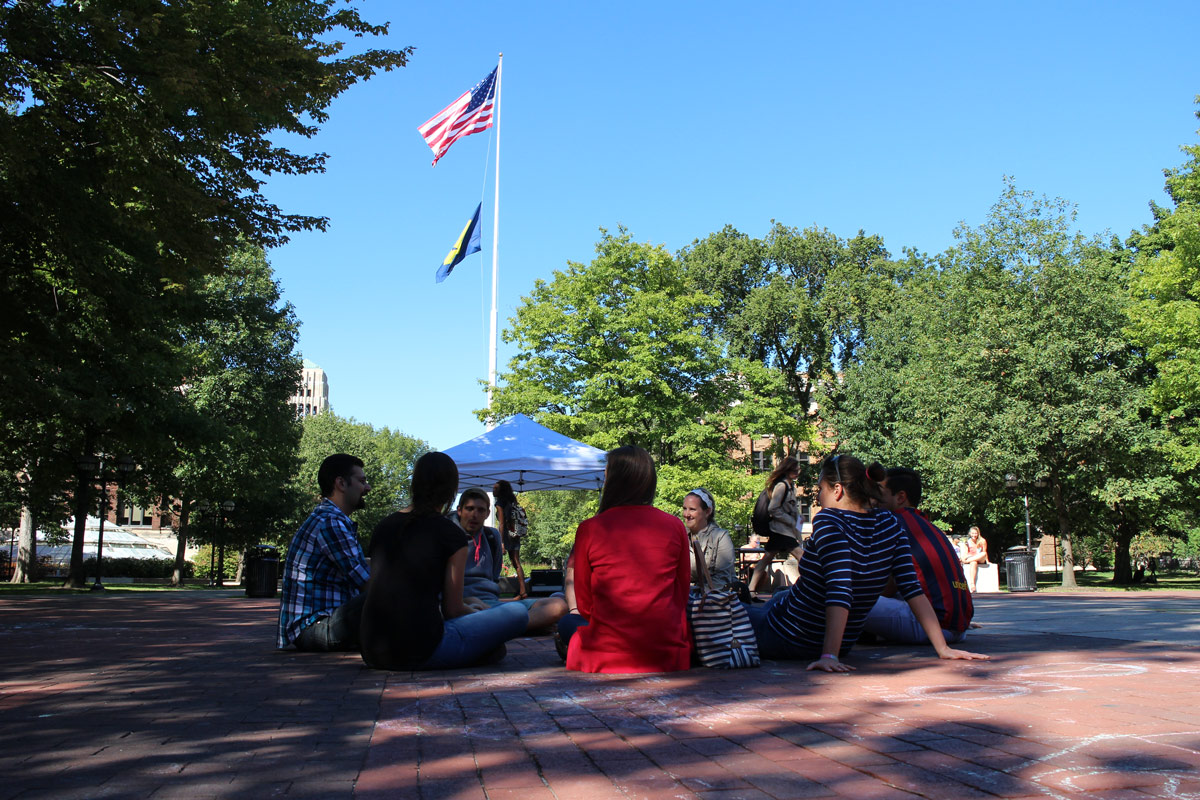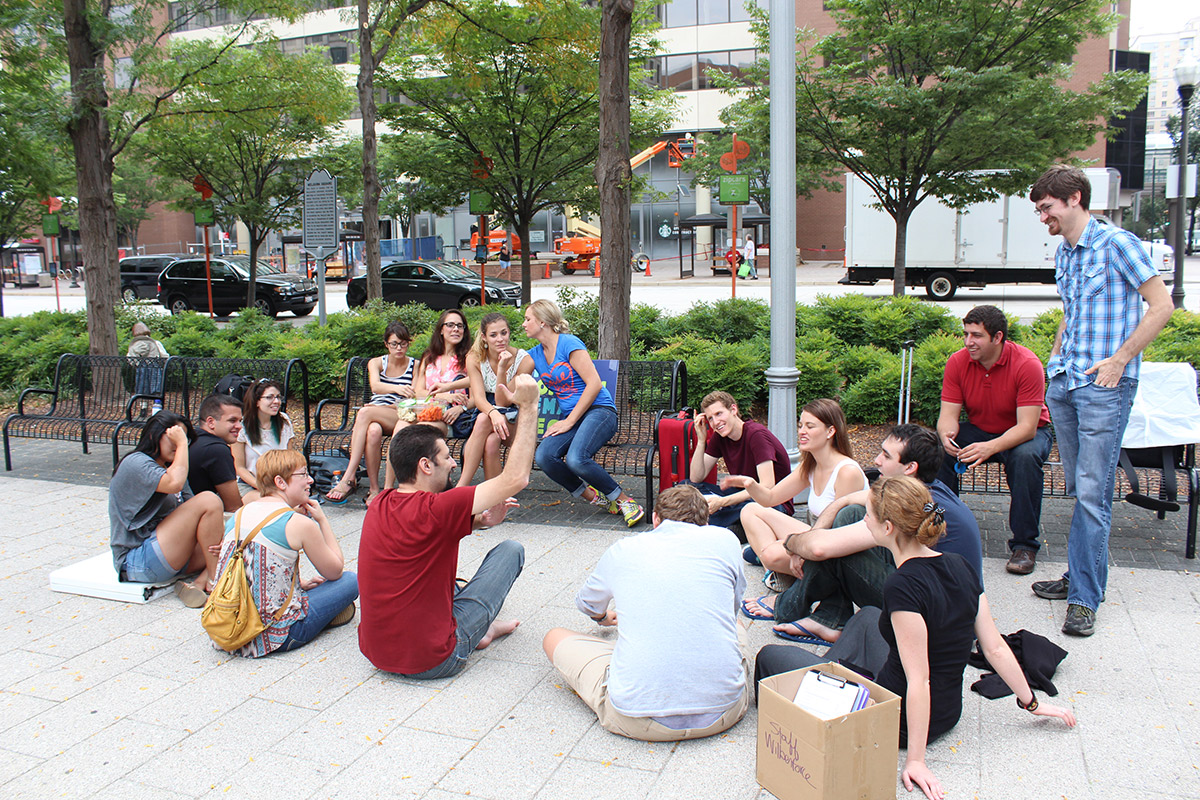I hope that as more groups purchase the Equipped for Life Course, they will be prepared to participate in more outreach events like polling tables. Having a strategic plan in mind and practical supplies on hand can help your event be a greater success. Speaking as the president of a Students for Life (SFL) group that does regular outreach, here are my ten tips:
Estimated reading time: 12 minutes.
#1: Code of Conduct Agreement
I highly recommend asking each volunteer to sign a code of conduct agreement prior to arriving at outreach so they know what sort of behavior is expected and prohibited. It can be as simple as a non-violence pledge and the information of an emergency contact. You’ll want to keep these forms in a folder or binder with you at the outreach site in case something goes amiss. It also makes it really easy to respond to angry pro-choice people that say we’re like people who bomb clinics. You can just say, “No, we aren’t,” but it’s more convincing to say, “No, we aren’t, in fact everyone from our club has signed a volunteer agreement stating that they are opposed to violence against abortion practitioners and their facilities.”
If it would help you get started, you can feel free to download the volunteer agreement ERI uses when leading outreaches and edit it however you see fit.
#2: Schedule Volunteer Shifts
You will need to have volunteers sign up for shifts throughout the day, preferably that overlap by 15-30 minute intervals so you can switch out gracefully. Keep in mind that you may run into a situation where several volunteers at a time will be in the middle of dialogues, so try to have as many people scheduled at the event as you can without creating a crowd around the table.

My preferred method for scheduling shifts is Doodle polls. You can create a Doodle poll at Doodle.com for free (see example above) and email out the link to all the SFL members. Print out the schedule so you have it at the table with you along with a contact number so if someone doesn’t show up you can give them a quick call to see if they are running late.
#3: Set Realistic Goals
It is critical that you set your volunteers’ expectations in such a way that they know the event was a success when it’s over. If they’re expecting to have ten conversations in one day and for half of them to result in someone completely changing their mind, they will be disappointed at the end. That doesn’t mean you had a bad outreach day, it just means that their expectations were too high from the beginning. Give everyone a goal of having at least one conversation with a pro-choice person. That is an attainable goal and is far less scary to your more timid members than a goal of 10 conversations and five changed minds.
Think ahead with your group when planning the day for your outreach. Ask members which dates work best for them before reserving a space outside or making other plans. If you give them a few options to pick from, you can determine which day you will have the most volunteers available. If you can get enough people for an all-day outreach, then plan to be set up during the times of the day when most people will pass by your table. Most tabling events I have had with my SFL group last 9am-3:30pm. If you have a smaller group, a half-day outreach might be more appropriate for you.
It is okay to have a goal for quality over quantity. It is best to have at least two people at the table at all times. As a general rule, it is good to have a balance of female and male students working together. Unfortunately, there are many misconceptions about pro-lifers, and having five guys hanging around the table will just look a little weird to the pro-choice girls on campus.
#4: Bring Essential Supplies
Underneath or somewhere near your outreach table, it can be good to have some water and light snacks for those who will be there for a few hours or more. We don’t want volunteers to eat while dialoguing, but it can make a significant difference to have something to eat during a break.
Some people joke that it never hurts to have duct tape. These people are your friends. They are wise, trust them, and keep some duct tape on hand. I would also strongly recommend packing sunscreen if you will be outside.
Recruiting members is such an important aspect of running a successful pro-life organization. Every event you host on campus should be a recruitment event. Always have a sign-up sheet on a clipboard for pro-life students who are interested. After you’ve collected their name, email, and phone number, make it a priority to follow up with them later that same day. Have small fliers with your supplies which have your contact email, the time and place information for meetings, and social media information to give to the pro-life students who have talked with you.

#5: Prepare Volunteers
Provide your volunteers with the information they need before they arrive at outreach. That way they are all set to go when they get there. It is so important to equip students before sending them out to try outreach. The first time I did outreach on campus as a college freshman, I was scared and nervous. I hadn’t had any training and had no idea what to expect. Talking through what usually happens at a tabling event at a meeting and encouraging students to give it a try can be helpful for them. Something I tell new students is that the largest obstacle pro-life students face on our college campus isn’t hostility, but rather apathy. Most people passing by are more likely to ignore us than they are to yell at us. This is true for my campus when we set up a polling table with a question. Equipping students with some dialogue training can make all the difference for them. They will feel more prepared. If students have a really bad outreach experience their first time because they weren’t properly equipped, they will be far less likely to want to volunteer for future events.
Other ways to prepare your volunteers:
- Each member of your group should have the local pregnancy resource center’s number saved in their phone, as well as know the important information like location, hours of operation, and services they provide. It is possible that a volunteer could meet someone who is in a crisis.
- All volunteers should also have the number of campus security. We don’t want to unnecessarily worry our club members, but we do want to keep them safe and to have the ability to easily reach out if something like vandalism occurs.
- Send out an email beforehand reminding volunteers to dress for the weather if you’ll be outside and to wear comfortable shoes. If you are going to be volunteering at a polling table, you want to look approachable, friendly, and put together.
#6: Avoid Wearing Clothes with Pro-Life or Religious Messaging
We want to make our odds of having great conversations as high as possible, so looking good is helpful. When I am doing outreach, I wear casual clothing that doesn’t have messaging on it, particularly pro-life, religious, or political statements which might distract from my mission that day. Anything I am going to say in a productive conversation about abortion is probably going to be way more persuasive than any message I could put on a t-shirt or hat. [Tweet that!] If I thought people would change their minds because of a t-shirt, then I would spend my outreach hours walking through crowds with my favorite pro-life t-shirt! I think it would be okay to wear a sports team or band t-shirt, but I’d be cautious about selecting your favorite “Jesus loves you” hoodie.
I love pro-life shirts as much as the next girl, but I also don’t want the misconceptions about pro-life people to hurt my conversations. I feel like trying to get pro-choice people to calmly engage with me is tough enough as it is, so I don’t need to add any obstacles. It is even better if you can send the message in the way you dress that you have common ground. For example, if you are a college pro-life group, wearing school apparel would be a great idea. It helps people passing by know that you are a student at the school just like they are.
Pro-life t-shirts are great outside the context of an outreach event. I have had many students ask me about my shirts when I wear them to class. Usually it is another pro-life student asking what my shirt means and then saying that they are surprised to hear that there is a pro-life club on campus when I tell them about Students for Life. This is such a great way to recruit new members! When it is a pro-choice friend asking, usually they make a strange face when I say that I am pro-life. If I get that strange expression from someone when I explain my t-shirt, I immediately open dialogue with a smile and a question: “Can I ask how you feel about abortion? I am interested in hearing your thoughts.”
#7: Avoid Distractions
It can be hard to resist, but avoid small talk with other volunteers. We want to take advantage of outreach time to make an impact on our campus, and chatting with each other can be a distraction. The same thing goes for being on your phone or allowing other things to take priority over the outreach at hand. Commit to making the most of your outreach time, and catch up on texts and Facebook later.
#8: Take Initiative

Don’t do this.
I’ve also seen volunteers stand right next to or behind a polling table and unintentionally stare down people walking by. This can be intimidating for people, so we want to avoid what I call the bird-of-prey outreach style. Be as casual as possible while moving about the table. It is okay to stand nearby, but we want to do so in a way that allows people to approach.
Don’t be shy! Invite people by waving or gently calling out to them if they are within about 10 feet of the area. I like to say, “Hi! Would you like to participate in our free speech table?” I like saying this because on my college campus and many others, people like free speech, and it communicates that we actually want them to write something down. You could also say, “Hello! Would you like to participate in our poll?” If they say no, just smile and wish them a nice day. Sometimes your friendly response will be a subtle way of debunking their assumptions about pro-lifers. Occasionally, it can even be enough to make them interested in coming back at a later time.
Sometimes people linger nearby but seem hesitant to engage. It is okay to walk over to them and introduce yourself. Ask them how they feel about abortion or invite them to write something down. We shouldn’t expect everyone to come to us. Some people are willing enough to have a conversation but not willing enough to initiate it. We don’t want to miss out on talking to them.
#9: Take pictures and document your conversations
If you are able to, assign a volunteer to take pictures of your group doing outreach. This would be a great task to assign someone who wants to help but doesn’t feel ready to have their own conversations yet. Encourage them to observe and learn, and to intentionally take pictures. You’ll want to be respectful of people passing by your table by having the face of your volunteer in the photo and only the back or profile of the person they are talking with in the photo. Afterwards, you can ask your volunteers to write up a story of their conversation and share it on your group’s social media or in a newsletter to donors to help them understand the work you do.
Pro tip: You’ll need to take several pictures to get one good one. People just look really weird when you take pictures of them while they’re talking, so it generally works best to take pictures while they’re listening to the pro-choice person. And encourage your students to smile when possible, to avoid looking like angry pro-lifers in the pictures. (Of course this cannot always be possible. If the student is listening to someone tell a very sad and personal story, they shouldn’t be smiling.)

It is important to reflect on conversations you have so that you can learn from them. You would be surprised how little of your conversations you will remember just twelve hours later. Trust me. Directly after a dialogue, if possible, take a moment to record what you talked about and any unresolved questions you had about the conversation so you remember to find the answer later. This can be done by writing down the key points of the conversation, although we’ve been preferring lately to record voice memos instead with our phones.
#10: Follow-up the Outreach with a Debrief Session
We usually break down our outreaches around 3:30, or whenever traffic slows down and there aren’t any more conversations going on. After we break down our stuff, we all find somewhere nearby to sit in a circle to talk about our experiences.

I always start these sessions by asking everyone to raise their hand if they had at least one conversation. (Remember the goal you gave them earlier?) Unless it was an awful outreach day or a bad spot on campus, virtually everyone should raise their hand. Then I’ll ask how many had two conversations. Most raise their hands. “How many had five conversations?” Your volunteers will be able to see that the day was a huge success.
Then I invite people to share stories from their day. People often share their favorite conversation: perhaps a person who changed their mind or at least ended up closer to the pro-life view than they were before. Sometimes these are stories of funny or weird things that happened. And sometimes people open up and share a story of a difficult conversation or something that happened that they’re struggling with. Lead by example and care for this person a lot and encourage them. Occasionally people will also share things that pro-choice people said that stumped them. Give a quick lesson on how you would have responded and/or invite the rest of the group to jump in.

Wrap it up by encouraging your members to share stories at the next club meeting for the benefit of the students who didn’t make it to the outreach, and remind them to write down as many stories as possible before the end of the day. After students have written down their stories, I ask them to send me the best ones by email so then we can post them on our Students for Life Facebook page. This is a great way to engage with our pro-life friends in the community and for students who aren’t really involved to get excited about SFL and want to be more active. Putting together the stories and matching them with good pictures is a great task to delegate to a newer member of the club to help them feel more involved, too.
Do you have a good dialogue story you want to share? Post it in the comments below! We would love to hear from you.
Please tweet this article!
- Tweet: 10 Practical Tips for Leading a Campus Outreach
- Tweet: Anything I say in a productive conversation is going to be more persuasive than any message I could put on a shirt.
- Tweet: We shouldn’t expect everyone to come to us. We don’t want to miss out on talking to them.
The post “10 Practical Tips for Leading a Campus Outreach” originally appeared at the Equal Rights Institute blog. Subscribe to our email list with the form below and get a FREE gift. Click here to learn more about our pro-life apologetics course, “Equipped for Life: A Fresh Approach to Conversations About Abortion.”

Please note: The goal of the comments section on this blog is simply and unambiguously to promote productive dialogue. We reserve the right to delete comments that are snarky, disrespectful, flagrantly uncharitable, offensive, or off-topic. If in doubt, read our Comments Policy.